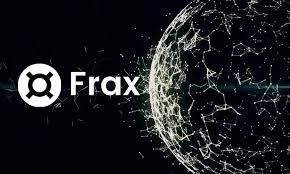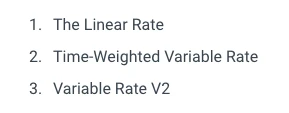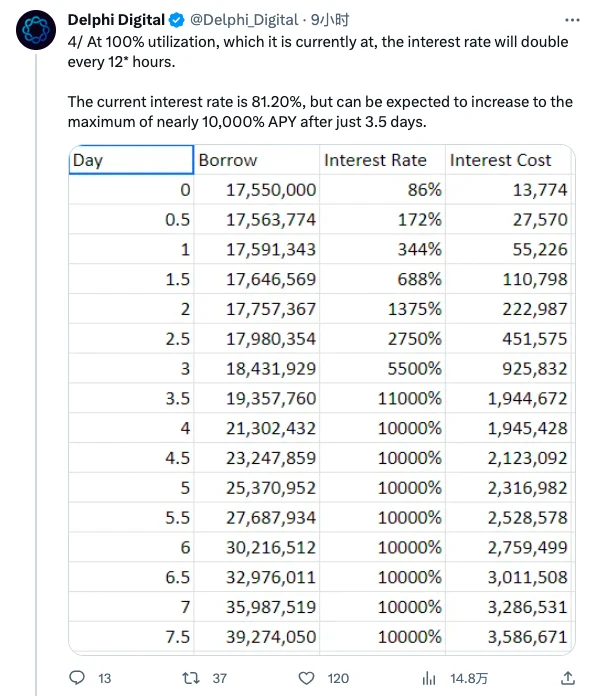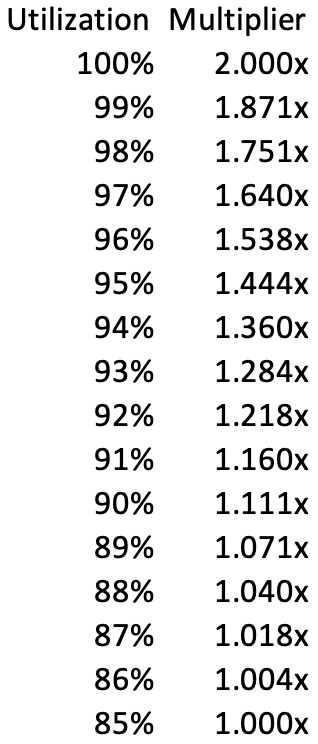As the personal debt risk of Curve founder Michael Egorov has escalated, there has been an increasing discussion surrounding the issue of Fraxlend interest rates.

The reason for this is that Fraxlend adopts a rather unique interest rate adjustment mechanism, which has led to a rapid increase in the loan interest rate in the CRV/FRAX market from yesterday to today, "forcing" Egorov to repay $7.13 million in debt on the platform this afternoon.
So, how exactly are Fraxlend's interest rates calculated? Why is this number rising so quickly? Combining the official documentation of Frax Finance and the tweets from its developer, Drake Evans, we have briefly summarized this algorithm.
According to the documentation of Frax Finance, Fraxlend uses three different interest rate change algorithms for different markets:

Linear interest rate: Simply put, it is a basic algorithm where the interest rate increases linearly with the market utilization rate.
Time-weighted variable interest rate: An algorithm that determines interest rate increases or decreases based on the market utilization rate and adjusts the interest rate at fixed time intervals.
Variable interest rate V2: A composite algorithm that combines the previous two, using the linear interest rate function to determine the current interest rate, but also using the formula of time-weighted variable interest rate to adjust the maximum interest rate.
Well, you might find this explanation even more confusing, but don't worry, let's continue.
According to Drake's explanation, the CRV/FRAX market of Fraxlend uses the second algorithm (time-weighted variable interest rate), and the operation mechanism of this algorithm is as follows:
First, Fraxlend sets a target utilization rate range for a specific market. When the market utilization rate is within this range, the interest rate does not need to change.
When the market utilization rate is below the target range, the interest rate will gradually decrease at specific intervals by a certain multiplier until it reaches the lowest interest rate.
When the market utilization rate is above the target range, the interest rate will gradually increase at specific intervals by a certain multiplier until it reaches the highest interest rate.
In Fraxlend's design, this specific interval is called the half-life, which refers to the time required for the interest rate to halve when the market utilization rate is 0, and also the time required for the interest rate to double when the market utilization rate is 0.
According to the contract of the CRV/FRAX market, its target utilization rate range is 75%-85%, the lowest interest rate is 0.5%, the highest interest rate is 10000%, and the half-life is 12 hours.

This also means that for the CRV/FRAX market:
When the market utilization rate is within the 75%-85% range, the interest rate does not need to change.
When the market utilization rate is below 75%, the interest rate will gradually decrease at a certain "multiplier" every 12 hours until it reaches 0.5%.
When the market utilization rate is above 85%, the interest rate will gradually increase at a certain "multiplier" every 12 hours until it reaches 10000%.
So, for a considerable period from yesterday to today, due to the overall utilization rate of the CRV/FRAX market within Fraxlend continuously being above 85%, and even close to 100%, this has led to a continuous increase in the loan interest rate of this pool.
However, this does not mean that the interest rate of this market will double every 12 hours as some rumors suggest (this claim comes from DelphiDigital, but in fact, DelphiDigital only listed the case of 100% utilization rate, and did not say it is a common occurrence after exceeding 85%), because in reality, the utilization rate of this market has not been continuously maintained at 100% (which is also impossible), so the "multiplier" mentioned earlier is not always doubled.

According to Drake's additional explanation, when the utilization rate of the CRV/FRAX market exceeds 85%, the multiplier for the growth of the interest rate varies for different levels of utilization rates.

As shown in the above figure, when the market utilization rate is 85%, the "multiplier" is 1, which means the interest rate will remain unchanged; but as the utilization rate increases, the "multiplier" will gradually increase, until it reaches 2 when the utilization rate reaches 100%, thus beginning the doubling growth as mentioned by DelphiDigital.

Currently, with Egorov's repayment, the utilization rate of the CRV/FRAX market has dropped to 53.68%, which means that if this situation is maintained, the interest rate will further decrease after 12 hours. In this way, Egorov's pressure will also be significantly reduced.
So, it is not difficult to understand why Egorov chose to repay part of the debt in Fraxlend early. At the very least, he needs to first suppress the interest rate, otherwise it would be really difficult to withstand the continuous increase.
免责声明:本文章仅代表作者个人观点,不代表本平台的立场和观点。本文章仅供信息分享,不构成对任何人的任何投资建议。用户与作者之间的任何争议,与本平台无关。如网页中刊载的文章或图片涉及侵权,请提供相关的权利证明和身份证明发送邮件到support@aicoin.com,本平台相关工作人员将会进行核查。




